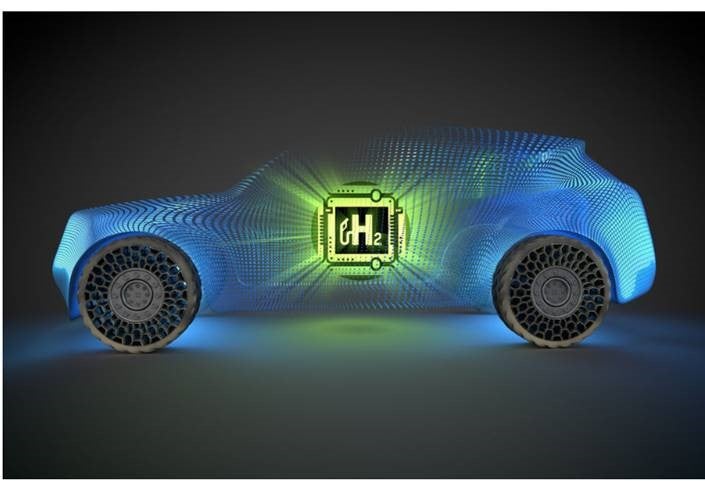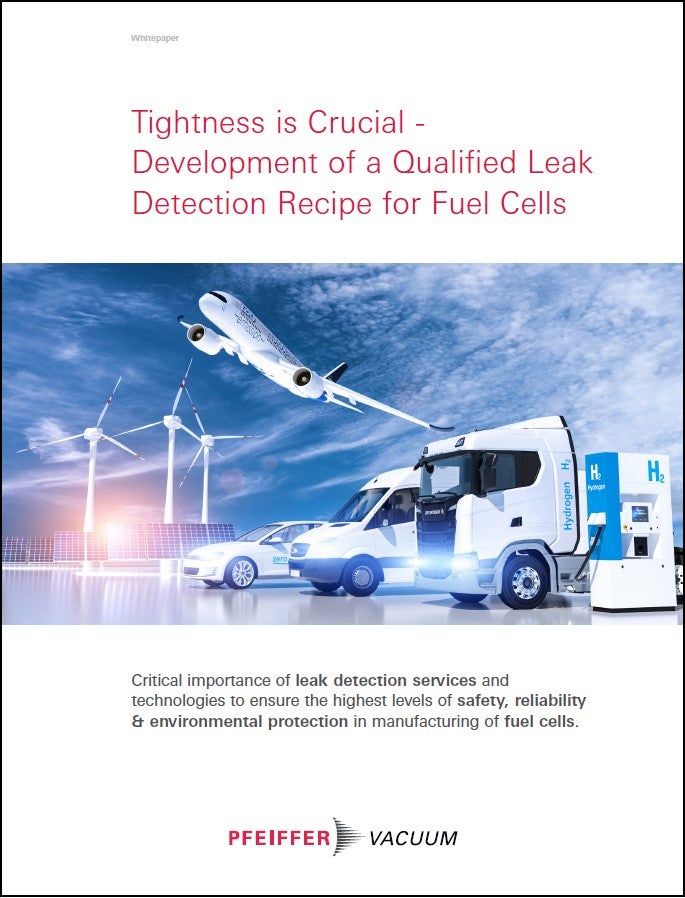
Due to the high safety risks inherent with the use of hydrogen gas, leak detection is well understood to be a critical aspect of the fuel cell production process. However, there is much less certainty around exactly which leak testing methods to deploy, with many methods and testing apparatus in use by the industry.

Tightness is Crucial – Development of a Qualified Leak Detection Recipe for Fuel Cells
Leak detection is critical in ensuring the highest levels of safety, reliability, and environmental protection when manufacturing fuel cells.
Hydrogen-based technology is a great tool for decarbonising the automotive segment, and battery-powered vehicles have helped this industry (and a host of others) reduce emissions worldwide.
In the long term, fuel cell electric vehicles (FCEVs) are seen as the most promising way to reduce the carbon dioxide emissions released into the atmosphere by long-haul global transportation systems such as cars, trucks, buses, trains, and ships.
Download this whitepaper to learn more about the technology behind this, why leak detection is so important, and how and why Pfeiffer Vacuum has led in the field of FCEV leak detection.
Thank you.Please check your email to download the Whitepaper.
Manufacturers can opt for several air-based methods such as pressure decay, differential pressure testing or flow-based methodologies. In addition, the use of pure hydrogen in approval tests or diluted hydrogen or helium is an option. All these methods are well implemented in the fuel cell industry, meeting the requirements outlined in regulations like EN 1779 or ISO 20485 for a quantitative and integral measurement of an inside-out flow direction.
Pfeiffer Vacuum is the only company in the world that manufacturers instruments for both air and tracer gas leak detection. Due to its neutral position in the market, the company prides itself on its ability to give highly application-specific advice to fuel cell customers. We spoke to Pfeiffer Vacuum’s specialist Dr Rudolf Konwitschny to find out more about applications for air and tracer gas leak detection.
Air or tracer gas?
Firstly, it is important to understand the major advantages and disadvantages of each method. Air-based leak testing is inexpensive, which makes it a popular option amongst manufacturers. “The lower the cost for fuel cell-related production, the better it is for the technology’s market introduction,” says Konwitschny.
The need for low cost must not sacrifice the fit-for-function characteristic of the test, however. The influence of environmental parameters such as volume change and temperature change can limit the sensitivity of the pressure decay test. Tracer gas methods, meanwhile, are not sensitive to these environmental changes, and therefore cycle times can be much faster with such methods.
Konwitschny explains: “With air-based methods, the compression heat needs to dissipate. The question is: do you have enough waiting time to allow the device to come to a thermal equilibrium? Is this in line with cycle time considerations? Of course, you can have multiple stations in parallel, but this can become a cost issue. The low cost of the individual testing device for leak testing with air may be consumed by the need for multiplying the individual test devices, in addition to the cost for industrial tooling and chambers.”
While a tracer gas method can be more efficient, reliable, repeatable, and reproducible, there are different costs associated with the technology. Tracer gas testing systems are often the more expensive equipment to purchase. There are also running costs to consider, with the price of the tracer gas itself being significantly more expensive than compressed air, although many fuel cell manufacturers will naturally have hydrogen available on the premises. In addition, when using tracer gases like hydrogen, safety issues and ‘background’ gas problems should also be acknowledged.
“There are many parameters according to which you can evaluate methods. These include detection limit, cycle time, volume range, and how easily the test can be influenced by environmental changes. We need to find a balance somehow,” summarises Konwitschny.
Matching test method to application
Leak testing is required for many different components of the fuel cell system, including the individual bipolar plates, complete fuel cell stacks, recirculation blowers, tubing, connections, cooling lines, and other parts. Due to their application requirements, some of these components call for a specific test method. Bipolar plates are a good example.
“The bipolar plate is often specified in a sensitivity range which typically cannot be reached when leak testing with air,” explains Konwitschny. “Sensitivity is the driving parameter to go to a tracer gas-based technique in vacuum.”
A fuel cell stack may be made up of 600 or 700 bipolar plates, forming a solid block that is not as temperature-sensitive as the individual plate. Pressure decay testing is mentioned in some regulations dealing with stack testing. In practice, often a differential pressure test is applied. The Micro-Flow technology developed by Pfeiffer Vacuum represents a faster and more sensitive option than traditional air testing technologies. With an industrial, rugged design, it is a great choice for testing small to average-sized fuel cell stacks.
As the fuel cell stack gets larger, though, increased volume can start to influence the test result. Konwitschny explains: “The larger the sample, the less suitable leak testing with air is because the pressure change you are measuring is diluted by a huge capacitance, namely the internal volume of the stack. Small fuel cell stacks have an internal volume in the half-litre class, and this is something you can easily measure with pressure decay. But there are also very large geometries of these stacks which tend to have a volume of several dozens of litres. Here, you cannot use pressure decay any longer.”
Another important consideration in larger stacks is the length of the seals between the plates. These can amount to 2km in length and can also affect the pressure loss during an air-based leak test. In these applications, a more sensitive leak test with tracer gas is advisable. Pfeiffer Vacuum offers many options that are suitable to the fuel cell market.
As the fuel cell industry gets closer to making hydrogen-powered vehicles and other stationary fuel cell-related systems a reality, it can lean on the help of Pfeiffer Vacuum’s unrivalled leak detection expertise. To further support the fuel cell market, the company is also working on new technologies. This includes solutions for faster cycle times, better sensitivity and improved gage repeatability and reproducibility in combination with attractive pricing in line with market requirements.
To learn more about the development of a qualified leak detection recipe for the manufacturing of fuel cells, download the whitepaper from Pfeiffer Vacuum below.

Tightness is Crucial – Development of a Qualified Leak Detection Recipe for Fuel Cells
Leak detection is critical in ensuring the highest levels of safety, reliability, and environmental protection when manufacturing fuel cells.
Hydrogen-based technology is a great tool for decarbonising the automotive segment, and battery-powered vehicles have helped this industry (and a host of others) reduce emissions worldwide.
In the long term, fuel cell electric vehicles (FCEVs) are seen as the most promising way to reduce the carbon dioxide emissions released into the atmosphere by long-haul global transportation systems such as cars, trucks, buses, trains, and ships.
Download this whitepaper to learn more about the technology behind this, why leak detection is so important, and how and why Pfeiffer Vacuum has led in the field of FCEV leak detection.
Thank you.Please check your email to download the Whitepaper.
